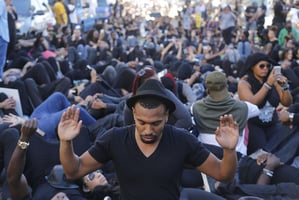As I started high school, I was a skinny kid. Most days found me outside playing ball in the...
Better Together
As a skinny young boy in Philadelphia, I had to learn to fight quickly. While I would never be the strongest on the street, I could be the smartest of the bunch. Thankfully, my competition for that title was limited. It didn’t mean that I would do others’ homework or let them cheat off me; instead, I used my smarts to become good friends with the strongest in my grade and in the grade above me. I was smart enough to know that these relationships would serve me well and used collaboration to do it.
So, when the movie, My Bodyguard, came out in 1980, I felt that I should have been paid royalties. I had done this. Chris Makepeace played Clifford, a new kid on the block who was easy pickings for Moody, played by Matt Dillon. Clifford is smart enough to hire Linderman (Adam Baldwin), the toughest kid in the school, to be his bodyguard. In the end, what Clifford needed is what Linderman needed – friendship. They wound up working together rather than one working for the other.
Isn’t that what life’s really to be like? Think about work, where you spend oodles of time (I have been wanting to use “oodles” for months) with a team of people, whether remote or in person. These people become your crew. And the healthiest crews know how to best leverage the strengths of the individuals to the benefit of the whole. Collaborative plans are made for projects to be completed in a way that utilizes time well based upon these individual skill sets. If we’re smart, this is how it should be.
However, there are areas of competencies that lie untapped due to a lack of exposure. Clifford would not have known how strong he was until he put himself in certain situations. The experiential learning environment is an overlooked commodity of many organizations. We believe “we can’t” much more so than “we can.” To combat this, a safe environment for experimentation and trial with a team of people focused on similar objectives should be fostered.
The dreaded pilot program comes to mind for some of you. Yes, I know. Frightening experience for some of you, but don’t let a bad roll ruin it all. A pilot program allows for such experimentation and can change the approach to future problems. When we have a stake in it, we hold it tighter and want to see whatever it is succeed. By having such a setting in place, these untapped or underdeveloped competencies can emerge. We see this even in training. Experientially formed training curriculum has a higher rate of retention and application than those out-of-the-box programs that do not involve team decisions in the content. We ought not underestimate how deeply this trail can take an organization.
Start small and enter a dialogue with your crew around collaborative work. How has our collaboration been? Is it effective? How might we engage differently to get better results? Ask your team and get ideas to consider. When you ideate, there is no commitment to any one idea, but it will expose interests, points of view, values and preferences. In the spirit of understanding and inclusion, having a forum for free expression has led to some significant positive movements and changes in organizations. The experience of collaboration gets wider and more innovative once this environment is fostered.
When you sit in front of your next Teams/Zoom/Skype call, ask about this. Start (or reactivate) the process of collaboration and experimentation. There’s no Bodyguard to pay to find out what others want, need or have to offer. Take advantage of the free option!
Find more HR related blog posts at https://www.humareso.com/blogs
See our list of HR services at https://www.humareso.com/our-services
Contact us at https://www.humareso.com/contact




Blog comments